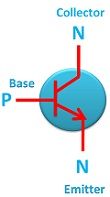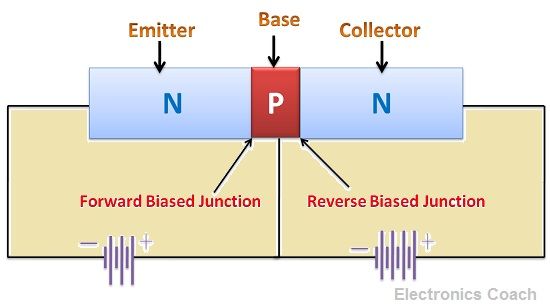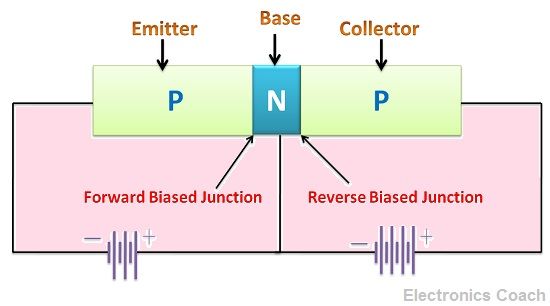The main difference between PNP transistor and NPN transistor is that the conduction in NPN transistor is due to electron while conduction in PNP transistor is due to holes. Another crucial difference between NPN and PNP transistor is the direction of flow of current, the current in NPN transistor flows from collector to emitter, on the contrary, the current in PNP transistor flows from emitter to collector.
The other differences between NPN and PNP transistor are biasing condition. The emitter terminal of NPN transistor is connected to negative terminal of the battery while the emitter terminal of PNP transistor is connected to the positive terminal of the battery.
The other significant differences are described with the help of comparison chart.
Content: NPN Transistor Vs PNP Transistor
Comparison Chart
| Parameters | NPN Transistor | PNP Transistor |
|---|---|---|
| Definition | Transistor which consists of one layer of P-type material sandwiched between two layers of N-type semiconductor. | Transistor which consists of one layer of N-type material sandwiched between two layers of P-type semiconductor. |
| Majority Charge Carriers | Electrons | Holes |
| Circuit Symbol |  |  |
| Direction of Majority Charge Carriers | Electrons flow from emitter to collector. | Holes flow from emitter to collector. |
| Direction of Current | Current flows from collector to emitter. | Current flows emitter to collector. |
| Direction of arrow in circuit symbol | Outwards from base terminal. | Inwards to base terminal. |
| Acts as | It acts as current source as it sources current from base terminal of transistor. | It acts like current sink as it completely sink the current towards base terminal. |
| Mobility of Charge carriers | Electrons possess high mobiltiy thus conduction is more | Holes are less mobile in copmparison to electron thus, PNP transistor provides less condcution. |
| Commonly Used | NPN transistor is used in most of the applications. | PNP transistor is less used in comparison to NPN transistor. |
| Frequency Response | Faster response than PNP transistors. | Slower frequency response. |
Definition
NPN Transistor
NPN transistor is formed by sandwiching P-layer of the semiconductor between two layers of N-type semiconductor. The majority charge carriers in NPN transistor are electrons. The full form of NPN transistor is Negative-Positive-Negative.

The NPN transistor starts conducting when the Emitter-Base junction is forward biased. In this emitter junction is connected to the negative terminal of the battery while the base of the transistor is connected to the positive terminal of the battery.
The electrons which are present in the emitter junction will repel from the negative terminal of the battery and move towards the base. The base is lightly doped region thus consists of fewer holes. Therefore, only a few electrons will recombine with holes and the remaining will flow towards collector region.
If we will arrange the base, emitter and collector in increasing order of their doping intensity, the base will hold the first position followed by collector and last in the list will be the emitter. Thus, the emitter is the highly doped region of the transistor.
The direction of electrons is from the emitter to collector thus, the direction of current will be from collector to emitter. This is because the direction of flow of current is opposite to that of flow of electron. The size of the collector is greatest among all regions. The base is smallest in comparison to other regions.
PNP Transistor
PNP Transistor is an acronym of Positive-Negative-Positive, it is formed by sandwiching an N-type layer of the semiconductor between two layers of P-type semiconductor. The majority charge carriers in PNP transistor are holes. The holes are responsible for conduction in PNP transistor.

The PNP transistor will conduct only when the base-emitter junction is forward biased and collector based junction is reversed biased. The emitter terminal of PNP transistor is connected to positive terminal of the battery while the base terminal of PNP transistor is connected to the negative terminal of the battery.
The holes present in emitter region will move towards the base region to recombine with electrons. Due to the lightly doped base region, only a few holes will recombine with electrons. The remaining holes will travel move towards collector region. As a consequence, current will flow from emitter to collector.
The direction of flow of current is same as the direction of flow of holes, this is because the holes are positive charge carriers and current is also because of the positive charge carriers. The size of the collector will be greater than the size of emitter and base because more charge carriers will be collected if the collector is of more size.
Key Differences Between NPN and PNP Transistor
- The major difference between NPN and PNP transistor is that the conduction in NPN transistor is because of electrons while the conduction in PNP transistor is due to holes.
- The emitter terminal of NPN transistor is connected to the negative terminal of the battery. On the contrary, the emitter terminal of PNP transistor is connected to the positive terminal of the battery.
- The direction of flow of current in NPN transistor is from collector to emitter while the direction of current in PNP transistor is from the emitter to collector.
- The conduction of NPN transistor is high than that of PNP because the mobility of electrons is more in comparison to that of holes.
- The circuit symbol of NPN and PNP transistor resembles each other except the direction of the arrow on the emitter. The direction of the arrow indicates the direction of current in the transistor. The arrow in NPN transistor point outwards from the base terminal while the direction of arrow points inwards in PNP transistor.
- The PNP transistor sinks all the current into the base region. This can be understood with the help of arrowhead towards the base. On the contrary, the NPN transistor sources the current with the help of base region.
- The NPN transistor turns ON when the base current starts increasing while the PNP is exactly of opposite of it.
- The NPN transistor takes more time to switch ON as compared to PNP transistor. This is because the current carrying charge carriers in NPN transistor is an electron.
Conclusion
The NPN transistor conducts current due to movement of electrons from low resistance region to high resistance region. PNP transistor conducts when holes move from low resistance to high resistance region.
Both are the subtypes of the transistor and both are used in amplification or switching process. The only difference between them is the conduction mechanism.
R. Devi shree says
A completed feel while reading the points itself.